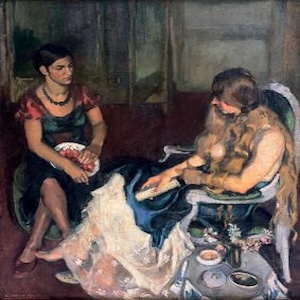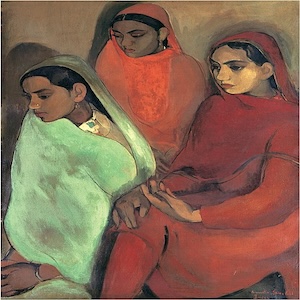Amrita Sher-Gil: Young Girls, Group of Three Girls


Annotation
Group of Three Girls (1935), and Young Girls (1932) were created by the early-twentieth century Indian artist, Amrita Sher-Gil. Sher-Gil’s paintings can be used in a global history context by exploring her depictions of girls and women, and how her transnational life and career experiences informed her identity and art in a rapidly globalizing world. She was born in 1913 in Hungary, and did not move to India until 1921. She would return to Europe to study art in Paris, but she ultimately embraced her Indian identity and heritage as an artist. Aesthetically, Sher-Gil was known for her use of colors, and her ability to capture traditional Indian cultural representations alongside her European training. The subject of Sher-Gil’s paintings are often women and girls, as she used art to explore the experiences of working-class Indian girlhood in her own time. Sher-Gil died in1941 at the age of only 28. Because of this, Sher-Gil created much of her work both as a teenager and as a young adult. She is referred to as the “Indian Frida Kahlo” due to the subjects of her painting and her use of color, and the Indian Government named her as a National Treasure Artist in 1976. Sher-Gil’s work is recognized as a major inspiration for modern and contemporary Indian artists that came after her. Many of her paintings are housed at the National Gallery of Modern Art in New Delhi.
In Young Girls, Sher-Gil explores her own split identity, depicting young women from both European and Indian descent. This painting reflects the artist’s quest for identity as she traveled back and forth between India and countries in Europe as a child and young adult. The painting was recognized as the “Picture of the Year” at the Ecole des Beaux Arts’ Grand Salon in 1932, when Sher-Gil was just 18. She became the first Indian artist to be given this honor. Group of Three Girls depicts three teenagers, all related to Sher-Gil, who sit passively with resigned expressions. The painting has been interpreted to signify how young, middle and lower-caste women were treated in early-twentieth Indian society as they could not participate as active members in politics or social life. This painting can be seen as a commentary of hope for a day when women and girls can take more active roles in their lives.
These paintings can be studied alongside the Girl Museum’s lesson plan, “Girl Child in India.”
Credits
Annotation by Hannah LeComte, George Mason University
Source locations: Girl Museum, https://www.girlmuseum.org/project/girl-child-of-india/; National Gallery of Modern Art India, https://artsandculture.google.com/partner/national-gallery-of-modern-art-ngma-new-delhi?hl=en.